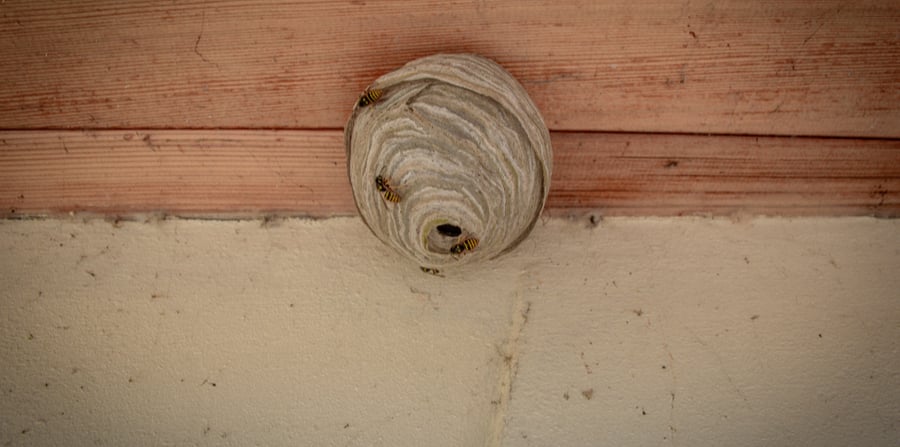Beetles are an insect making up the Coleoptera order. There are over 40,000 species of Coleoptera, making it the largest order of insects in the world. In fact, the Coleoptera order make up 25% of ALL known animal life forms. There are tens of thousands of beetle species in North America. Fortunately, most of those species are completely harmless to both people and property. You’d probably either never notice them or only see them in passing.
Unfortunately, however, not all the beetle species in North America are harmless. We have our fair share of pests, too. We’ve split up these pests into four broad categories based on the kind of damage they can inflict. These are the types of beetles you might have to worry about, and how to tell them apart:
Stored Product Beetles
Like all stored product pests, stored product beetles infest dry goods you store in dark, secluded areas such as a pantry or cupboard. These pests feed on and lay eggs in various dry food including grains, flour, nuts, sugar, and more. There are a wide variety of common stored product beetle troublemakers:
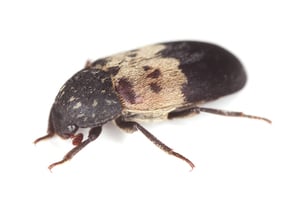
- Larder beetles (Dermestes lardarius) are common all over the world. They’re ¼ to ⅜” long, oval-shaped, and dark brown or black with a large yellow band on their wings. Larder beetles feed on both stored animal products and, occasionally, plants.
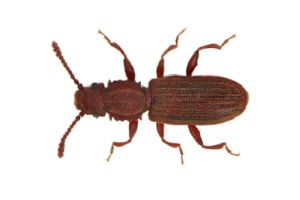
- Sawtoothed grain beetles (Oryzaephilus surinamensis) are very common in North America. They’re around ⅛” long, narrow and flat, and dark brown in color. Sawtoothed grain beetles eat crumbs of a wide variety of dry food stuff. They’re common in pantries.
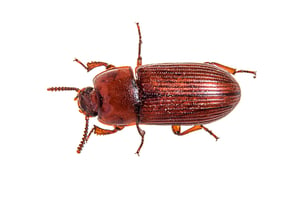
- Red flour beetles (Tribolium castaneum) and Confused flour beetles (Tribolium confusum) are two different beetle species that look and behave very similarly. They’re both ⅛” long and dark red. These beetles feed on grain products and other dry goods.
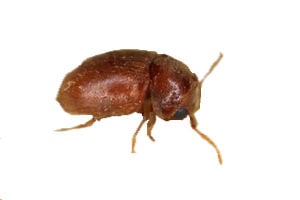
- Cigarette beetles (Lasioderma serricorne) are another stored product pest that’s common all over the world. They’re less than ⅛” long, oval-shaped, and light brown. These pests infest dried spices, leaves, and beans. They’re common in tobacco.
Wood-destroyers
Wood-destroyers feed on and/or live inside wood, damaging it in the process. Different wood-destroyers infest different types of wood for different reasons. Most wood-infesters are called “powderpost” because they commonly attack “posts” of wood, reducing them to a fine “powder.” Powderpost beetles often infest old furniture. No matter what kind of wood they infest or why, these pests inflict structural damage in the process. There are three types of common wood-destroying beetle most common in the US:
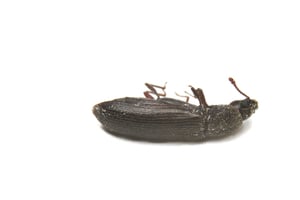
- Lyctid powderpost beetles are a broad family of very small (only around one sixteenth of an inch) insects with elongated, narrow bodies. These pests attack the sapwood of old hardwood. Their larvae do all the feeding and wood damage.
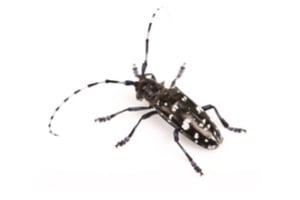
- Longhorned beetles actually comprise several species of beetle, all of which have distinctively long antennae. Longhorned beetles lay eggs in wood, and their larvae feed on and drill into wood materials.
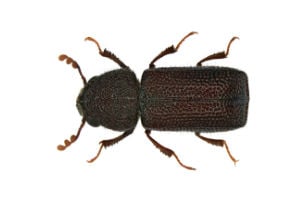
- Anobiid powderpost beetles are a family of the most commonly-encountered “powderpost” infesters. Anobiid powderpost beetles feed on inner sapwood, and only attack old wood.
Carpet Infesters
As the name implies, carpet beetles infest carpeting and other fabrics. These pests feed on, lay eggs in, and damage fibrous material. Virtually every species of carpet beetle is oval-shaped and only around ⅛” long. Most carpet infesters behave similarly, too, so the primary way to tell them apart is their coloration. These are the carpet infesters you’re most likely to encounter in and around your home:
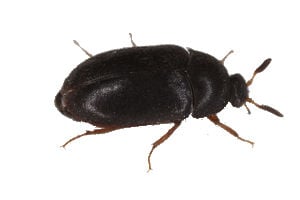
- Black carpet beetles (Attagenus unicolor) are the most common carpet infesting beetle in the US. Adults are a dark, uniform black color, and larvae are cigar-shaped with long bristles. Larvae eat large, irregular holes through carpet and other fabric.

- Varied carpet beetles’ (Anthrenus verbasci) wing covers, or “elytra” are covered in distinctive colorful spots of white, brown, and yellow, giving the beetle a “splotchy” appearance. They eat dead insects and a wide variety of fabric material.
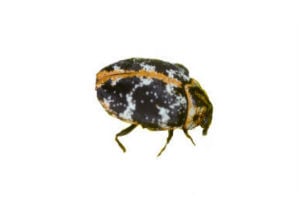
- Common carpet beetles (Anthrenus scrophulariae) are black but covered with distinctive white scale patterns. Adults also have orange and red scales running down their midline. Like other carpet beetle species, larvae do the damage, feeding on wool and fibers.
Nuisance Pests
Unlike the other beetle types on this list, these pests don’t necessarily do serious damage. In fact, they may not do any noticeable damage around your property at all! Instead, they’re simply annoying. Really annoying. Well, and they might chew up your plants. Mostly it’s really the annoying thing, though. Here are the most common nuisances you might see flying around your home:
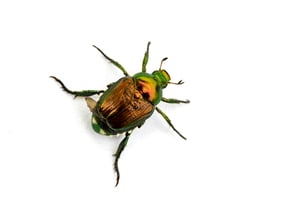
- Japanese beetles (Popillia japonica) are an invasive beetles species. They’re small, and have green heads and metallic-looking, iridescent copper-colored elytra. Japanese beetles are a problem because their grubs eat turfs.
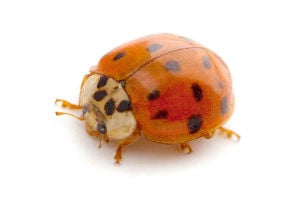
- Asian lady beetles (Harmonia axyridis) are the beetles that look just like ladybugs. Unlike ladybugs, however, Asian lady beetles are an invasive species. They cluster around buildings and secrete gross-smelling liquid pheromones.
Obviously, these aren’t all the beetles you might encounter on any given day. Far from it, in fact! These are the pests you might have to worry about finding in or around your property, however. Despite their often striking appearance, beetles behave just like any other insect pests. That means you can deal with them just like any other insect pests, too.
If you have a beetle problem, feel free to give Plunkett’s a call any time. No matter which one of these pests you’re contending with, we know how to deal with them for good. In fact, we can help even if you don’t know which beetle you’re dealing with! We’ll figure it out and kick them out, guaranteed.

